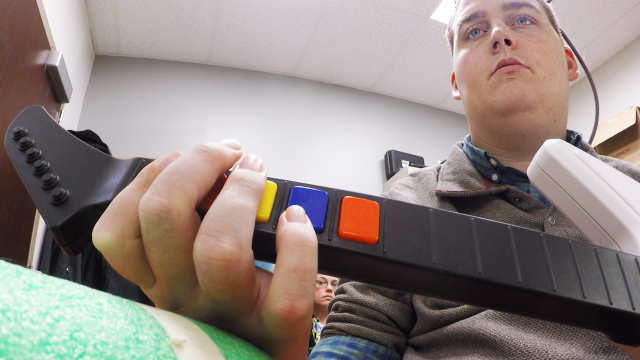Using synthetic nervous system, paralyzed man is first to move again
Source: Beth Mole
 Ohio State University Wexner Medical Center/ Batelle
Ohio State University Wexner Medical Center/ Batelle
With a paralyzing spinal cord injury, the biological wiring that hooks up our controlling brains to our useful limbs gets snipped, leading to permanent loss of sensation and control and usually a lifetime of extra health care. Researchers have spent years working to repair those lost connections, allowing paralyzed patients to sip coffee and enjoy a beer with robotic limbs controlled by just their minds.
Now, researchers have gone a step further, allowing a paralyzed person to control his own hand with just his mind.
In a study published Wednesday in Nature, researchers report using a “neural bypass” that reconnects a patient’s mental commands for movement to responsive muscles in his limbs, creating somewhat of a synthetic nervous system. The pioneering patient, Ian Burkhart, a 24-year-old man left with quadriplegia after a diving accident almost six years ago, can once again move his hand. In the pilot study he could control movement of individual fingers, grasp big and small objects, swipe a credit card, and play Guitar Hero. The advance may open the door to restorative treatments for paralyzed individuals, allowing them to have independent movement—and lives.
These complex types of movement “really can translate into a lot of functional, daily tasks that I can’t do on my own right now,” Burkhart said during a press conference. “So that’s something that, if or when I can use this system outside of the clinical setting, it will really increase my quality of life and my independence, and decrease the amount of assistance I need from other people.”
The neural bypass works using a microelectrode array implanted in Burkhart’s brain. The implant picks up activity in a specific area of his left motor cortex, which researchers had analyzed prior to placing the implant. Using functional magnetic resonance imaging (fMRI), which tracks brain activity based on blood flow, the researchers pinpointed the hand-controlling area of Burkhart's brain while he repeatedly thought about moving his hand.
In the clinic, the implanted electrode hooks into a custom-built “neural bypass system.” The system picks up the signals from Burkhart’s brain activity, then, using machine learning algorithms, translates those signals to control a flexible arm sleeve, outfitted with 130 muscle-stimulating electrodes.
To get it to work, Burkhart attended three weekly sessions for 15 months. He mastered controlling his thoughts and could pull off six hand and wrist movements, including the ability to move individual fingers.
| }
|